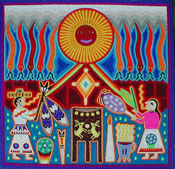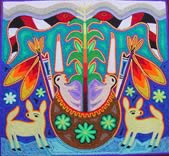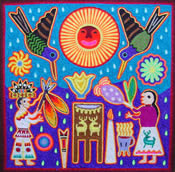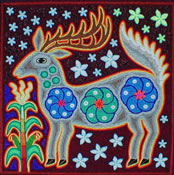|

These
works of art are Huichol yarn drawings, depicting important elements of
their nature - based spirituality.

Each
one is handmade by painstakingly placing colored pieces of yarn on a small
board covered with resin.

The
creators of these pieces live in a remote Huichol ceremonial center and
work in the evenings, when all other chores are done, by the light of
a candle (there is no electricity).

Click
here to see drawings currently for sale, with 100% of the proceeds
going back to the community.

|
One of the most profound
influences in the life of James Endredy has been his connection with the
Huichol Indians who live hidden in the western Sierra Madre Mountains
of Mexico. The core Huichol communities and ceremonial centers have been
able to preserve their nature-based traditions and worldview even into
this 21st century. The absence of roads and electricty in their core homeland
has kept the modern world at bay. Included below is an excerpt from the
final comments of Jim's book - Earthwalks for Body
and Spirit: Exercises to Restore our Sacred Bond with the Earth -
where he briefly explains the importance of indigenous communities like
the Huichol.
The
insights gleaned while physically and psychically interacting with the
spirit of Nature are richer and deeper than anything we could read about,
talk about, or even imagine. These insights are needed now more than ever
as we embark on the task of transforming our acquisitive civilization
into one that lives in harmony with Earth.
The impetus needed to perform this great task must be found in the hearts
and minds of modern people, whose greatest pathology is the rejection
of their place within the balanced life systems of the planet. But we
cannot rely solely on our contemporary culture for the answers to this
illness. Our great technological advances have failed us by creating a
society dependent on the exploitation of natural resources, and our contemporary
mainstream religions have failed to adequately promote the sacredness
of Earth. In short, most of our modern institutions can't be trusted to
deliver us from our current situation because they are precisely what
have brought us here.
For humanity to live harmoniously with Earth we must find our niche within
the living systems of Earth and live within its boundaries, just as all
other living things do-and just as ancient and surviving Nature-based
cultures do.
The ancient human cultures that still live separate from the modern world
must not be overlooked as we search for how to make our society more viable.
People who don't depend on trucks and planes to bring them food, don't
drive cars to and from work, and don't depend on machines of war to protect
their living spaces or possessions can surely teach us something precious
about life. They can show us how to bring our spirituality down to Earth
and how to live harmoniously with the environment. They hold the remnants
of our lost past that we must first recover, then protect and nurture.
We need to walk back down the path from which we came to discover where
we made the wrong turn and then, carrying what we have learned, begin
to walk a new path.
This is not to imply that we should all start living exactly as indigenous
people do. What I'm suggesting is that we consider what would happen if
instead of conquering and dismissing the worldview of the last remaining
Nature-based communities, we would respect them and learn about the differences
between their cultures and ours in order to better asses our current situation
and the many steps necessary for our recovery.
In doing so, however, we should not imitate the spiritual practices, customs,
or ways of life of native peoples. Each indigenous group has developed
in a unique way that relates to the environment in which its people live
and the life situations they have encountered in that place and over time.
Our place and our world today are far different from theirs. What we can
do, though, is learn how to develop our relationship with Earth by incorporating
their worldview into our own. Developing our own practices and traditions
from the clues found in nature-based cultures can also provide us with
the determination so desperately needed to save these cultures from extinction.
Too many beautiful and profound Earth-honoring cultures have already disappeared.
I urge you to support the many organizations helping to preserve these
last indigenous peoples.
At the same time, we should be careful not to disturb the delicate balance
of such cultures through our help or influence. Participants in my workshops
often ask if it is possible to walk with the indigenous people and shamans
whose influences are responsible for the creation of many of these Earthwalks.
Ironically, it is precisely their separation from the modern world that
has allowed peoples like the Huichol to survive. The world's core indigenous
communities most often live in extremely remote areas and are not easy
to reach. If our contact with them or their sacred places is not carried
out carefully and respectfully, mere contact becomes significant disruption.
Every day such people are being pushed into smaller areas. Every day their
sacred places are being violated to the point that even they can't visit
them anymore - a tragic circumstance that every indigenous group on our
continent has had to deal with since the arrival of the first ships from
Europe. Those people whom I know, love, and respect - my brothers and
sisters of the mountains, the Huichol - live largely as they have for
thousands of years. Unless we have been invited by a particular indigenous
group, which is happening more as they see how sharing with us helps heal
Earth, we should honor their solitude and isolation from our world.
The question of whether we can walk with them, however, can be considered
from another point of view: We can walk with them every day of our lives
by walking with the same Earth - honoring energy and intention in our
hearts as they have in theirs; by walking with our animal relatives, the
trees, and the nierikas; and of course by walking with each other. We
can share these Earthwalks with the people we love - and even with those
we may not even know. The magic of walking in Nature and the benefits
of reconnecting with Earth are things we should all share.
I genuinely hope to meet you out walking someday, to enjoy with you a
ray of sunshine and a breath of air, to walk together for a moment, or
a lifetime.
Click here to see the Huichol yarn drawings
currently for sale. For more specific information about supporting the
Huichol, please return to this page as we will be updating it to present
information on Jim's activities with the Huichol.
|
|